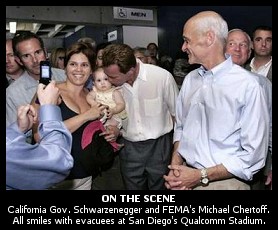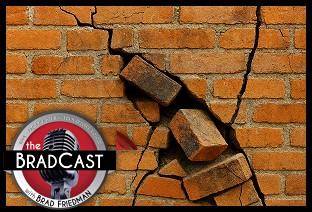Special to The BRAD BLOG by Miriam Raftery from San Diego, CA
 “It’s like Armageddon,” Jill Michaels said, after watching her home burn to the ground in the Harris fire. In the early hours of the worst fire in California history, the Michaels family received no evacuation warning and found exit routes blocked, forcing them to turn back to their home in Potrero. Now, the Michaels are among half a million evacuees who have fled four raging wildfires, the worst fire disaster in California history. Worse even than the 2003 Cedar fire, which until now held that shameful record.
“It’s like Armageddon,” Jill Michaels said, after watching her home burn to the ground in the Harris fire. In the early hours of the worst fire in California history, the Michaels family received no evacuation warning and found exit routes blocked, forcing them to turn back to their home in Potrero. Now, the Michaels are among half a million evacuees who have fled four raging wildfires, the worst fire disaster in California history. Worse even than the 2003 Cedar fire, which until now held that shameful record.
San Diego County now has more refugees than New Orleans after Hurricane Katrina. While reported loss of life thus far remains low, hundreds of thousands of acres have been scorched and countless people will soon return home--only to find themselves homeless.
Governor Arnold Schwarzenegger and local officials have made media appearances claiming credit for swiftly responding to the disaster. “There is much more equipment available, more manpower is available, quicker action,” Schwarzenegger said, according to the Associated Press.
What the Governor failed to mention is that he vetoed four bills that would have increased staffing and fire resources after the Cedar Fire, at a cost of tens of millions of dollars. A fifth bill, signed by Schwarzenegger, requires local governments to first submit safety plans to the California Department of Forestry and will not take effect until 2010, the Los Angeles Times reported in a May 20, 2007 article titled “Fire danger acute as 2003 lessons fade.” That article has since disappeared off the newspaper’s website, but a copy is here.
The same story cited Dallas Jones, former director of the Governor’s Office of Emergency Services and current official with California Professional Firefighters union. Jones damned Schwarzenegger for failing to provide additional firetrucks. “How many years are we since the ’03 fire siege?” he asked, “and so far, nothing.”
Other unfulfilled recommendations made to Schwarzenegger by his Blue Ribbon Fire Commission include replacement of aging fire helicopters, increasing staffing to assure four person crews on each state fire engine sent to major wildfires, and nighttime air drops.
A national contract fleet of heavy air tankers has fallen from 41 to 16 in the last five years, with aging aircraft deemed unsafe and grounded. The state firefighting fleet has not replaced two air tankers that crashed, the L.A. Times reported.
CNN reports that only 1,500 National Guard have been sent to assist Californians during the current wildfire crisis—less than 1/10 of the state’s 20,000 National Guard members. Clearly having the bulk of our National Guards forces deployed to war zones in Iraq and Afghanistan have hindered emergency response here at home.
 Some improvements have been made since the Cedar Fire, including coordination with the military to help combat fires, but even those are inadequate. Four Marine helicopters at the Miramar Marine Corps Air Station are equipped with buckets to fight San Diego’s fires—but remain grounded because Cal Fire officials insist the choppers can’t fly without state fire crew spotters on board – and there are none available. Not even Congressman Duncan Hunter (R-Alpine), former chair of the House Armed Service Committee has yet been able to resolve this bureaucratic SNAFU.
Some improvements have been made since the Cedar Fire, including coordination with the military to help combat fires, but even those are inadequate. Four Marine helicopters at the Miramar Marine Corps Air Station are equipped with buckets to fight San Diego’s fires—but remain grounded because Cal Fire officials insist the choppers can’t fly without state fire crew spotters on board – and there are none available. Not even Congressman Duncan Hunter (R-Alpine), former chair of the House Armed Service Committee has yet been able to resolve this bureaucratic SNAFU.
Six national Guard C 130 retardant-dropping airplanes were winging their way to San Diego yesterday – but why weren’t such aircraft deployed two days earlier, when it was clear that fires were burning out of control with what fire officials termed a “perfect storm” for disaster: hot weather, the driest conditions in years, and gale-force Santa Ana winds?
Both the Harris and Witch fires now devastating San Diego began in Supervisor Dianne Jacob’s district—the same area where the 2003 Cedar fire started.
So what did Jacob have to say to the public and the press on Monday, one day after two major fires continued burning unchecked through her constituents’ communities?
“There’s no stopping this fire, so the best we can do is get out of the way,” Jacob announced.
But others contend the County Supervisors must shoulder a heavy share of blame. Two wildfire survivors, Mark Hanson and Rudy Reyes, have announced plans to run for Supervisor, citing fire safety as a key issue. Ironically, Reyes, who was burned over 60% of his body in the Cedar Fire, announced his plan to run against Supervisor Dianne Jacob on the morning the Harris Fire began, before the vast scope of the blaze was yet known.
Critics contend that the Board has failed to adequately improve fire protection manpower and equipment, while allowing rampant development in fire-prone areas. The County also recently approved a controversial shelter-in-place policy, allowing developers to build projects in back country communities, even box canyons, without having to provide secondary access routes for escape in case of fire, creating potential death traps if a fire exceeds the ability of firefighters to control it. Jacob has called for consolidation of rural fire districts under County leadership, but some worry that closing rural volunteer fighting stations could leave rural areas unprotected if future budget cuts pare down County firefighting forces.
Some improvements were made after the Cedar Fire, including adding some helicopters, improving communications, and utilizing a reverse 911 warning system that worked well in many areas. However the County’s efforts have clearly proven woefully inadequate to prevent yet another horrific fire disaster.
“Studies show that we need a regional airport with tankers and helicopters that have a massive capacity to respond,” Hanson, candidate for Supervisor, said shortly before the current fires broke out. “The Supervisors haven’t done that…We need a regional air force with night helicopters and faster access to a fleet of C130 planes, that’s now in Riverside. Then we could douse fires before they get up and going.”
Supervisors and the State have also drawn criticism for allowing closure of honor camps in San Diego County’s back country, where prisoners once cut firebreaks to prevent wildfires from spreading out of control. Hanson, who lost his home in the Cedar Fire, said it took CDF firefighters six hours to cut through an overgrown firebreak the night the Cedar Fire began. “One crew with shovels could have annihilated it anytime within the first two hours,” he said, “but nobody could get to it.”
Supervisor Dianne Jacob has recently expressed interest in returning to use of prisoner programs to clear brush. But her concern is too little, too late.
A former honor camp prisoner, who asked that his name not be published, recalled the importance of firebreaks in halting fires. “When a fire broke out, our first line of defense was the firebreaks that we cut. The whole back country would be checker-boarded with firebreaks on those ridges. We would use them as a trail for our trucks and take a crew out to the boonies…We would contain the fire by making that firebreak the first line of defense. . . I was never in a fire that we couldn’t control, because you could always fall back to the next firebreak.”
Asked why he thought officials had failed to reopen the honor camps even after the 2003 Cedar Fire, the former prisoner recalled, “It’s expensive to cut those, and labor intensive. I guess it’s cheaper to lock people up in cages than maintain all those camps,” he added, noting that prisoners were paid 70 cents a day to cut firebreaks or $1.50 an hour when a fire was burning. “Doing away with this program has obviously been a disaster…You have to have a plan and work it year around,” he said in a prophetic interview held before the current fires began. “We were doing something that was worthwhile, even lifesaving.”
ED NOTE: The original headline for this article began with "Worse Than Katrina." While Miriam Raftery, the San Diego resident who wrote and originally headlined the story, was referring to the number of evacuees as she points out in the article, the comparison to Hurricane Katrina, by including that phrase in the in the headline, (currently) overstates the issue as we see it. It also understates the devastation of Katrina. For those reasons, we've now removed the "Worse Than Katrina" part of the headline in the above article. Raftery, who is likely out reporting on the story, was unavailable, so we were unable to consult her for comment before making the change.


 'Green News Report' 1/6/26
'Green News Report' 1/6/26
 Trump's War on Venezuela is About Ego, Power, Creation of 'Alien Enemies': 'BradCast' 1/5/26
Trump's War on Venezuela is About Ego, Power, Creation of 'Alien Enemies': 'BradCast' 1/5/26 Sunday 'Peace President' Toons
Sunday 'Peace President' Toons Sunday 'Many Happy Returns' Toons
Sunday 'Many Happy Returns' Toons Have a Holly Jolly Somehow
Have a Holly Jolly Somehow 'Tis the Sunday Before Christmas Toons
'Tis the Sunday Before Christmas Toons Old Man Shouts at People from White House for 20 Minutes, and Other Year-End Matters: 'BradCast' 12/18/25
Old Man Shouts at People from White House for 20 Minutes, and Other Year-End Matters: 'BradCast' 12/18/25 'Green News Report' 12/18/25
'Green News Report' 12/18/25 SCOTUS Ruling a How-To for Unlawful Gerrymandering on 'Eve' of Critical Election Year: BradCast' 12/17/25
SCOTUS Ruling a How-To for Unlawful Gerrymandering on 'Eve' of Critical Election Year: BradCast' 12/17/25 Bricks in the Wall: 'BradCast' 12/16/25
Bricks in the Wall: 'BradCast' 12/16/25 'Green News Report' 12/16/25
'Green News Report' 12/16/25 'This One Goes to 11': Weekend of Violence, Murder of Rob Reiner: 'BradCast' 12/15
'This One Goes to 11': Weekend of Violence, Murder of Rob Reiner: 'BradCast' 12/15 Sunday 'WTF?' Toons
Sunday 'WTF?' Toons Trump Now Losing One Battle After Another: 'BradCast' 12/11/25
Trump Now Losing One Battle After Another: 'BradCast' 12/11/25 'Green News Report' 12/11/25
'Green News Report' 12/11/25 Dems Continue Stunning 2025 Election Streak: 'BradCast' 12/10/25
Dems Continue Stunning 2025 Election Streak: 'BradCast' 12/10/25 Petrostates and Propa-gandists Undermining Climate Science: 'BradCast' 12/9/25
Petrostates and Propa-gandists Undermining Climate Science: 'BradCast' 12/9/25 The High Cost of Trump's Terrible Policy Making: 'BradCast' 12/8/25
The High Cost of Trump's Terrible Policy Making: 'BradCast' 12/8/25 Dems Fight to Avoid GOP's Year-End Health Care Cliff: 'BradCast' 12/4/25
Dems Fight to Avoid GOP's Year-End Health Care Cliff: 'BradCast' 12/4/25 A 'Flashing Red Warning Sign' for GOP: 'BradCast' 12/3/25
A 'Flashing Red Warning Sign' for GOP: 'BradCast' 12/3/25 Hegseth, War Crimes and DoD's 'Politicization Death Spiral': 'BradCast' 12/2/25
Hegseth, War Crimes and DoD's 'Politicization Death Spiral': 'BradCast' 12/2/25 Follow the
Follow the  With Thanks, No Kings and Good Cheer
With Thanks, No Kings and Good Cheer
 VA GOP VOTER REG FRAUDSTER OFF HOOK
VA GOP VOTER REG FRAUDSTER OFF HOOK Criminal GOP Voter Registration Fraud Probe Expanding in VA
Criminal GOP Voter Registration Fraud Probe Expanding in VA DOJ PROBE SOUGHT AFTER VA ARREST
DOJ PROBE SOUGHT AFTER VA ARREST Arrest in VA: GOP Voter Reg Scandal Widens
Arrest in VA: GOP Voter Reg Scandal Widens ALL TOGETHER: ROVE, SPROUL, KOCHS, RNC
ALL TOGETHER: ROVE, SPROUL, KOCHS, RNC LATimes: RNC's 'Fired' Sproul Working for Repubs in 'as Many as 30 States'
LATimes: RNC's 'Fired' Sproul Working for Repubs in 'as Many as 30 States' 'Fired' Sproul Group 'Cloned', Still Working for Republicans in At Least 10 States
'Fired' Sproul Group 'Cloned', Still Working for Republicans in At Least 10 States FINALLY: FOX ON GOP REG FRAUD SCANDAL
FINALLY: FOX ON GOP REG FRAUD SCANDAL COLORADO FOLLOWS FLORIDA WITH GOP CRIMINAL INVESTIGATION
COLORADO FOLLOWS FLORIDA WITH GOP CRIMINAL INVESTIGATION CRIMINAL PROBE LAUNCHED INTO GOP VOTER REGISTRATION FRAUD SCANDAL IN FL
CRIMINAL PROBE LAUNCHED INTO GOP VOTER REGISTRATION FRAUD SCANDAL IN FL Brad Breaks PA Photo ID & GOP Registration Fraud Scandal News on Hartmann TV
Brad Breaks PA Photo ID & GOP Registration Fraud Scandal News on Hartmann TV  CAUGHT ON TAPE: COORDINATED NATIONWIDE GOP VOTER REG SCAM
CAUGHT ON TAPE: COORDINATED NATIONWIDE GOP VOTER REG SCAM CRIMINAL ELECTION FRAUD COMPLAINT FILED AGAINST GOP 'FRAUD' FIRM
CRIMINAL ELECTION FRAUD COMPLAINT FILED AGAINST GOP 'FRAUD' FIRM RICK SCOTT GETS ROLLED IN GOP REGISTRATION FRAUD SCANDAL
RICK SCOTT GETS ROLLED IN GOP REGISTRATION FRAUD SCANDAL VIDEO: Brad Breaks GOP Reg Fraud Scandal on Hartmann TV
VIDEO: Brad Breaks GOP Reg Fraud Scandal on Hartmann TV RNC FIRES NATIONAL VOTER REGISTRATION FIRM FOR FRAUD
RNC FIRES NATIONAL VOTER REGISTRATION FIRM FOR FRAUD EXCLUSIVE: Intvw w/ FL Official Who First Discovered GOP Reg Fraud
EXCLUSIVE: Intvw w/ FL Official Who First Discovered GOP Reg Fraud GOP REGISTRATION FRAUD FOUND IN FL
GOP REGISTRATION FRAUD FOUND IN FL

































